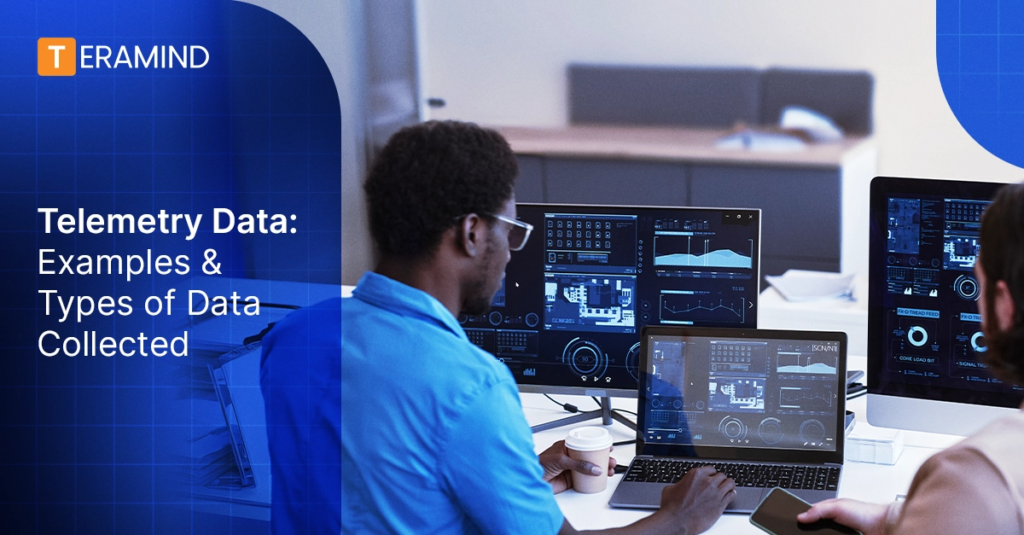Telemetry data automatically collects and sends data from various devices to a central location for analysis and monitoring. However, not all data is created equal. To better understand data telemetry and how to leverage it, you also need to understand the different types of data telemetry.
This article will discuss various telemetry data examples and types to help you better understand the topic.
Telemetry Data Examples
Let’s check out real-world examples of how telemetry data is generated and used.
Performance Metrics for Software Applications
Telemetry data tracks the performance of software applications by focusing on key performance metrics like response time, crash frequency, and CPU or memory usage.
For example, suppose an application starts slowing down after an update. Telemetry data can quickly point this out and alert your software developers that the update has an issue.
Sensor Data from IoT Devices
IoT sensors in a corporate setting, such as access control systems or environmental monitoring devices, generate data that can signal security breaches.
For example, a database access card reader that records entry attempts at unusual hours could indicate an attempted security breach.
User Engagement Data in Mobile Applications
User engagement data in mobile devices tells us how people use the app – e.g., how long they stay, how often they visit, and which parts they interact with most.
Once you have these key performance indicators for mobile devices and the activities within applications, you can use the data to spot unusual behaviors that could be security risks, such as a high number of app actions in a short time that might suggest a bot attack.
Network Traffic Analysis for Security Purposes
Network traffic analysis checks the flow of data to find any unusual activity that might indicate a security threat, such as malware or unauthorized data access.
For example, traffic analysis might reveal a series of requests from an unfamiliar location attempting to access sensitive areas of the network – which would trigger an alarm for a potential intrusion attempt.
Types of Telemetry Data
Telemetry analyzes millions of data points daily, which can often seem overwhelming. But with the proper categorization, it all begins to make more sense. Below, we’ll explore the most important and common types of telemetry data.
Employee Behavior Telemetry Data
Employee behavior telemetry data tracks how employees use work computers, applications, websites, communication tools, and files in real-time. It monitors user activity patterns such as application usage, website visits, email communications, and document access.
This data allows companies to:
- Identify inefficiencies and optimize workflows
- Optimize resource usage
- Detect potential security threats or policy violations
- Pinpoint areas where employees need additional training or better automation tools
For example, telemetry data may show that sales representatives spend hours daily navigating between different CRM systems and spreadsheets to log customer interactions and close deals. In this case, you may speed up the process by integrating the systems or using a more centralized system.

Endpoint Performance Telemetry Data
Endpoint performance telemetry data monitors the health and efficiency of devices connected to a corporate network, such as computers, smartphones, and tablets. This data provides actionable insights into system performance metrics like CPU usage, memory utilization, disk activity, and battery status.
This data allows IT teams to:
- Proactively identify and resolve device performance issues
- Troubleshoot and optimize software for better user experience
- Ensure telemetry devices follow security protocols like updated antivirus, firewalls, and authorized software
For example, telemetry may reveal high CPU utilization on certain laptops due to an inefficient app update. Your IT team could then improve that app’s performance within the user interface.
Sensor Telemetry Data
Sensor telemetry data refers to information that sensors collect about the operational state or activities within a corporate environment. These sensors might be physical devices (e.g., surveillance cameras or access control systems for network monitoring) or software-based sensors embedded in network equipment (e.g., firewalls, routers, or endpoint devices).
This data can help you:
- Get invaluable insights such as unusual network traffic or unauthorized access attempts
- Spot sudden drops in performance that might indicate a denial-of-service attack
- Detect real-time changes in environmental conditions like temperature, which might indicate tampering with data centers or hardware
For example, if this type of telemetry data detects electronic device activity at non-operational hours, it may indicate a security breach that needs investigation.
Location Telemetry Data
Location telemetry data monitors the geographical positions of employees, devices, and other company assets in real-time. This also includes the locations of remote workers, employee movements on company premises, and personnel positions at field sites/operations.
This data allows you to:
- Prevent unauthorized access to restricted areas
- Ensure compliance with safety protocols in hazardous environments
- Verify that remote employees are working from the designated remote locations
For example, location telemetry could alert you if an employee attempts to access confidential client data from an unauthorized remote destination (such as a cafe).
User Telemetry Data
User telemetry data revolves around data related to user behaviors and interactions within systems and applications. It includes logs and records of user actions, such as login/logout times, file access details, application usage patterns, and command execution histories.
This data helps you:
- Understand user activities across a network and spot discrepancies that could indicate security threats
- Detect suspicious or abnormal activities that might indicate insider threats, such as abnormal transfer of large data files outside company servers
- Get valuable insights into the actions leading up to and following the incident, which helps with forensic analysis and prevents similar future breaches
For example, user telemetry data triggers your system if the same user account logs in from two different countries within an hour—something that’s nearly impossible under normal circumstances. This anomaly can trigger an immediate security alert, suggesting a potential account compromise.
Application Telemetry Data
Application telemetry data refers to data generated by applications regarding their performance, usage, and behavior. It includes metrics on application performance (e.g., rapid response times, and telemetry system resource utilization), logs of user interactions within the application (e.g., input data and command usage), and database error reporting (which captures data on application malfunctions or failures).
This application performance data helps you:
- Quickly spot security risks and weak spots
- Monitor performance indicators like response times, system uptime, and areas where it might be lagging
- Quickly find and fix software development issues
- Run tests to see how changes to the software affect its security and performance
For instance, when analyzing application performance, a sudden increase in error messages from one area might suggest a security attack like a DDoS.
Network Telemetry Data
Network telemetry data focuses on the data about the activities and status of a company network. It analyzes factors such as traffic patterns, bandwidth usage, packet loss, network device performance, and logs of network events.
This data helps you:
- Maintain the telemetry system and network security, performance, and reliability
- Monitor data flow across the network to identify unusual traffic that may signify a security threat
For example, network telemetry might find an unexpected increase in encrypted traffic from an employee’s device to a suspicious online location. This anomaly could indicate malware attempting to establish a command-and-control channel to download harmful software.
Security Telemetry Data
Security telemetry data plays a crucial role. It refers to the data collected from various security analytics tools and systems designed to monitor and protect a company’s IT infrastructure. It includes a wide range of information from security devices, such as firewalls, intrusion detection systems (IDS), intrusion prevention systems (IPS), and antivirus programs.
This data helps you:
- Get deep visibility into security-related events across the entire corporate environment and see if there are any performance bottlenecks
- Keep detailed records of telemetry system security incidents for compliance and investigations
- Assess your overall security posture and make data-driven decisions if anything needs to be improved based on a real-time view of what’s happening
For example, if the system notices unusual late-night data transfers from a server, it might suggest someone is trying to secretly take data. Security teams can investigate to confirm whether this is a regular or malicious activity and stop it if necessary.
Conclusion
Telemetry data is more than numbers and logs—it’s one of the fundamental parts of a modern cybersecurity system.
Once you understand this data and its different types, you can improve your security and see which areas need to be optimized.


